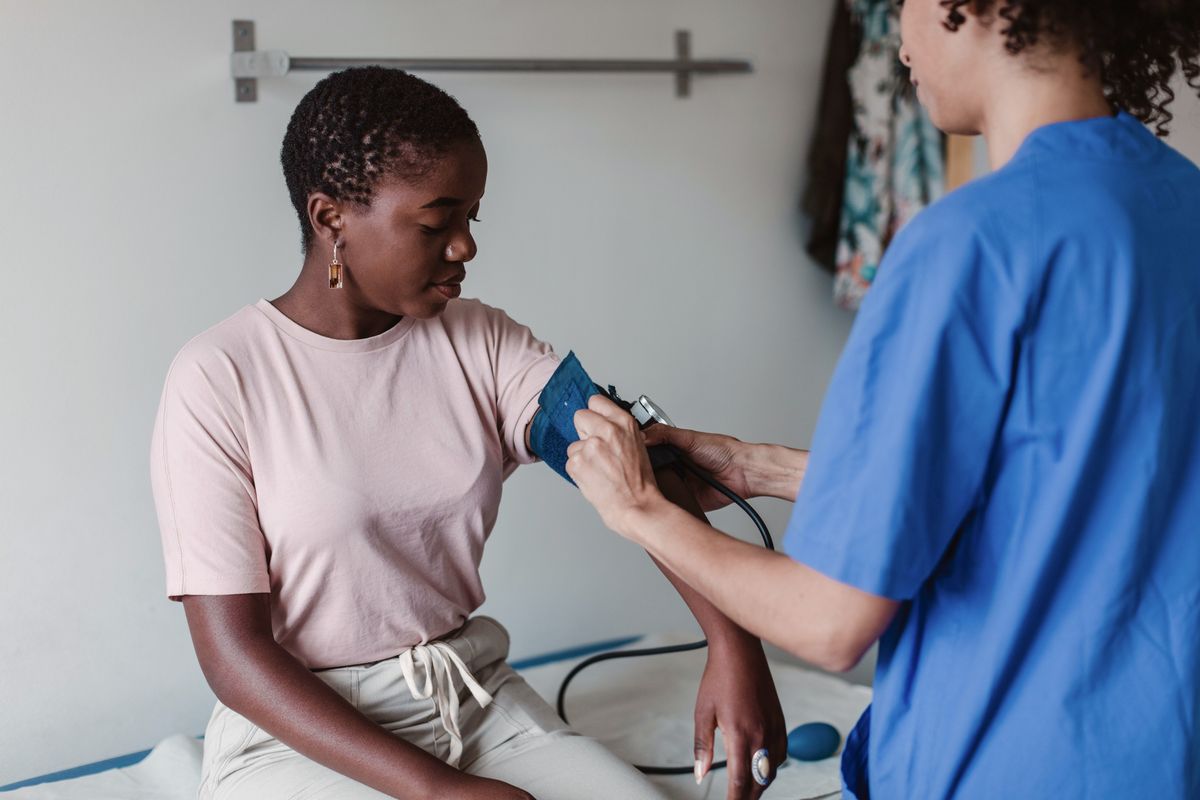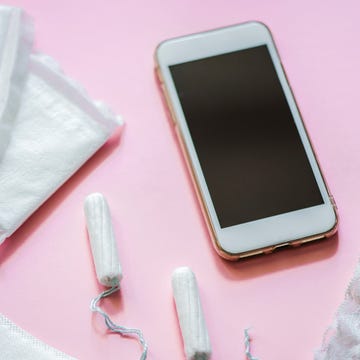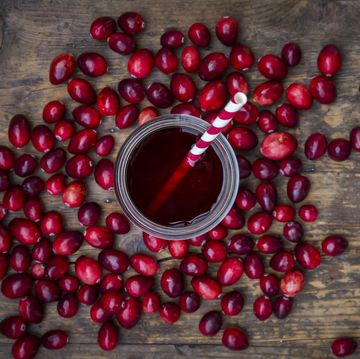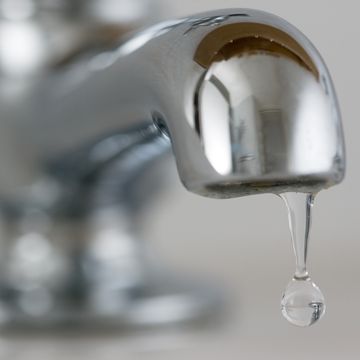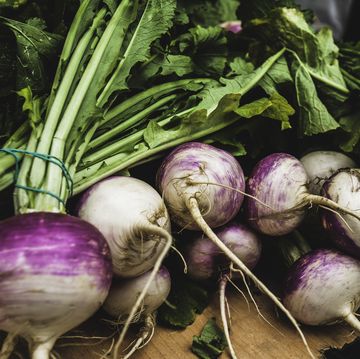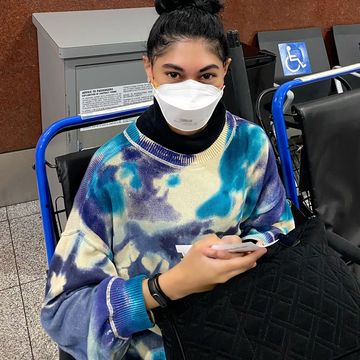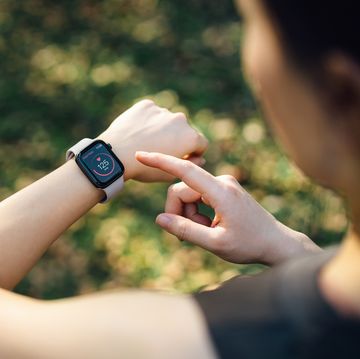You've probably had your blood pressure measured a ton of times at the doctor's office or even at the dentist. It's one of those health markers that you likely don't give a lot of thought to until something's off, or you have a family history of blood pressure probs.
But it's worth understanding *before* you have something to worry about—including how to lower high blood pressure if that becomes a health concern for you. Let's get into it.
So, what exactly is a blood pressure measurement?
Blood pressure, or arterial tension, is the pressure at which the blood flows through the arteries, or the pressure your blood exerts on the walls of your arteries, according to Lauren Munsch Dal Farra, MD, an internal medicine physician, cardiologist and CEO of PALM Health in St. Louis. “When your blood pressure is measured, there are two values, maximum and minimum, expressed by two numbers separated by a slash,” she explains. “For example, 135/85 millimeters of mercury (mmHg) means a maximum pressure of 135 and a minimum pressure of 85.”
The first number in the measurement is also know as systolic blood pressure, which is the pressure in the arteries when the heart beats. The second number is diastolic blood pressure, which is the arterial pressure between beats, says Sameer K. Mehta, MD, a board-certified cardiologist and president of Denver Heart. The difference between the two pressures is known as pulse pressure.
“The exact importance of pulse pressure is still being investigated, though some studies suggest that patients with a wide pulse pressure (greater than 60 mmHg) are at higher risk for heart disease, stroke, or death,” says Dr. Mehta.
What's a normal blood pressure level?
A "normal" or healthy blood pressure measurement is less than 120/80, Dr. Dal Farra says.
A maximum exceeding 140, or a minimum higher than 90, indicates the person has what's called hypertension, or high blood pressure. Anything over 180/120 is considered severe hypertension. While hypertension often has no symptoms, over time, it can lead to heart conditions like heart disease and stroke.
“When systolic pressure, or the top number, is between 121 and 139, and the diastolic pressure, or bottom number, is between 81 and 89, we call it prehypertension,” she explains. “Prehypertension means that the person does not have hypertension, but they will in the future unless they correct unhealthy habits.”
How do you accurately measure blood pressure?
“Blood pressure actually fluctuates a lot over the day, and even a healthy person will at times have the maximum exceeding 160 and the minimum number above 110,” says Dr. Dal Farra. “If they occur on an occasional basis, these values are perfectly normal and do not mean a person has hypertension.”
To gain an accurate understanding of your blood pressure, Dr. Dal Farra recommends using a blood pressure monitor, which you can buy at a pharmacy, to take your blood pressure once to twice daily, at different times of the day, in various circumstances, over a period of three weeks, and averaging the results. Make sure you haven't smoked, had caffeine, or exercised within 30 minutes of measuring your BP.
Why is a healthy blood pressure level important?
High blood pressure comes from an increase in resistance of the arteries, Dr. Dal Farra says. Your heart has to work harder to get blood to your extremities and vital organs due to this resistance. Over time, this can have negative effects on your body.
“Having high blood pressure increases the risk of major cardiovascular and non-cardiovascular events, including stroke, heart attack, death, and kidney failure,” says Dr. Mehta. “Similarly, controlling hypertension reduces the risk of all of these potential adverse outcomes.”
How can I lower my blood pressure naturally?
Here are the lifestyle changes to make that can help lower your blood pressure without medication.
Practice regular aerobic exercise
Physical activity is the most important lifestyle habit to cultivate to help lower blood pressure. The best exercises for reducing blood pressure (and cholesterol) are aerobic exercises like brisk walking, cycling, or swimming, per studies with hypertensive volunteers. To make an improvement in cardiovascular conditioning, you should aim to do aerobic exercise at least 30 minutes a day, three times a week.
“Although exercise raises your blood pressure while you’re doing it, regular exercise tends to lower it the rest of the time,” Dr. Dal Farra says. “Even without weight loss, regular exercise helps prevent high blood pressure.”
Reduce stress
Over time, low-grade chronic stress can lead to high blood pressure, increased heart rate, and muscle tension. For people who feel stressed, practicing relaxation techniques such as meditation and stretching can be beneficial, Dr. Dal Farra says.
Lose weight if you are medically overweight or obese
Blood pressure rises with body mass index, so for people who are overweight or obese, weight loss is the most effective measure for lowering blood pressure, Dr. Dal Farra says. “Studies suggest that blood pressure can be reduced by 1 mmHg for each one to two pounds lost,” she says. “Losing 20 pounds could drop blood pressure by 5-20 mmHg.”
Aerobic exercise, strength training, and nutrient-rich food plans are the essential components of weight loss, Dr. Dal Farra says. She recommends increasing the consumption of fruits, vegetables, high-fiber foods, and complex carbohydrates and eating less saturated fat and simple sugars.
Eat less salt and more potassium
The American Heart Association suggests limiting sodium to less than 1500 mg a day to prevent hypertension. “Most people can self-regulate and excrete extra salt and water in their urine, so reducing salt does not significantly impact blood pressure,” explains Dr. Dal Farra. “However, reducing salt intake is beneficial for people who are ‘salt-sensitive,’ have an imbalance in their salt and potassium ratios, have congestive heart failure, or have kidney disease.”
Studies suggest that more important than just lowing salt is maintaining the correct salt to potassium ratio, Dr. Dal Farra adds. Having a healthy balance of the two minerals (less salt, more potassium) in the body is crucial to maintaining healthy BP.
She recommends eating a plant-based, whole-food diet high in naturally potassium-rich foods, such as broccoli, spinach, beets, beet greens, tomatoes, tomato sauce, carrots, starchy vegetables such as potatoes and winter squash; lentils and beans (especially white beans and soybeans), fruits like bananas, oranges, cantaloupe, honeydew, apricots, grapefruit, and some dried fruits, such as prunes, raisins, and dates.
Limit your alcohol consumption
While research hasn’t shown alcohol to have a direct tie to blood pressure and heart health, it can contribute to weight gain, which is in turn related adverse heart health outcomes.
“Alcoholic beverages contain a large number of calories that contribute to obesity, so if weight loss is a goal, then alcohol should be limited as much as possible,” Dr. Dal Farra says. It's recommended that men limit themselves to two drinks per day, and women limit their alcohol consumption to one drink per day, Dr. Dal Farra says.
The bottom line: If you’re concerned about your blood pressure levels, talk to your doctor about what effective lifestyle changes you can make. While there are medications that can help lower BP, there are plenty of natural methods you can try as well.

Emilia Benton is a Houston-based freelance writer and editor. In addition to Runner's World, she has contributed health, fitness and wellness content to Women's Health, SELF, Prevention, Healthline, and the Houston Chronicle, among other publications. She is also an 11-time marathoner, a USATF Level 1-certified running coach, and an avid traveler.
